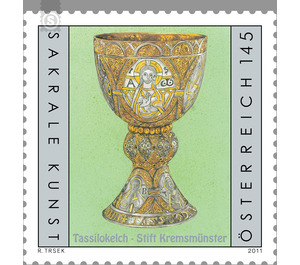Sacred art - Austria / II. Republic of Austria 2011 - 145 Euro Cent
Theme: Art & Culture
| Country | Austria / II. Republic of Austria |
| Issue Date | 2011 |
| Face Value | 145.00 |
| Edition Issued | 250,000 |
| Printing Type | combination printing |
| Stamp Type | Commemorative |
| Item Type | Stamp |
| Chronological Issue Number | 2280 |
| Chronological Chapter | OOS-OE2 |
| SID | 301194 |
| In 56 Wishlists | |
The aesthetic stamp shows the Tassilo chalice donated around 780 by the Bavarian Duke Tassilo and his wife Luitpirga, presumably to found Kremsmünster. The exact history is unclear. Since the inscription at the foot of the chalice presupposes the wedding of Tassilo, only an emergence after 768/69 comes into question. As a place of manufacture, a Salzburg workshop is suspected, but it is also the Bavarian or northern Italian area can not be completely ruled out. The braided band and animal ornaments elaborated in the insular style of continental imprint led in former times to the assumption that the valuable vessel might also have been made in England. The copper Tassilo chalice is about 25 cm high and weighs 3 kg, Kuppa and Knauf were made as individual pieces. On the partially gilded goblet, silver medallions are soldered on, with the five large bust pictures on the Kuppa Christ with the initials IS (Jesus Salvator), surrounded by the four evangelists, the smaller ones at the foot of St. Mary and John the Baptist, and, after an uncertain Interpretation showing Langobardeninin Theodolinde and the holy Theoto. In addition, the chalice is richly decorated with ornaments in various styles and techniques, several plant ornaments and geometric motifs. Due to the size and elaborate design of the chalice, it is probably a so-called "donation chalice" ("calix ministerialis"), which was (and still is) used during particularly festive church services to give the faithful the Chalice. Of course, one detail suggests this assumption in particular: the ring of metal beads above the knob is freely rotatable. This facilitates the handling in the presentation to several communicants in succession; The goblet can thus be easily rotated by the communion donor after each person - this can be seen as evidence of the practice of the cup communion in those days. It is interesting that also Pope Benedict XVI. used the goblet at the celebration of the Holy Mass in Mariazell on September 8, 2007. The inscription at the foot of the precious jewel reads "TASSILO DVX FORTIS + LIVTPIRC VIRGA REGALIS", which translates to "Tassilo, brave Duke + Liutpirg, royal scion" - an indication that, as mentioned earlier, it was the Wedding goblet of Tassilo should act.


